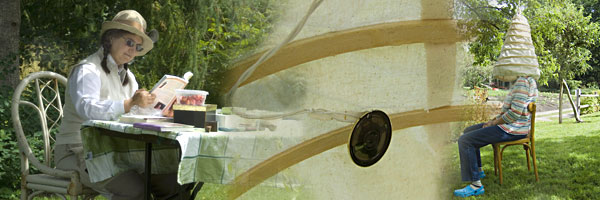2 0 0 7 |

Second Site at VanDusen Botanical Gardens.
Located at 37th and Oak Street in Vancouver. Opening on Saturday June 30 and Sunday July 1, 2007. Different works/events will run every day through July. Hours are 11 am to 4 pm daily, unless it is raining. (Check the Calendar for more details.)
Presenting the work of Diana Burgoyne, Peter Courtemanche, David Floren, Ken Gregory, Robin Ripley, Matt Smith, and Lori Weidenhammer.
In the summer of 2007, Second Site collective presented a series of outdoor interventions and installations at the VanDusen Botanical Gardens in Vancouver. These inventions were intended to question the connections between contemporary technology-driven industry, social constructs, and dependence on threatened agriculture and bio-diversity. The works presented at VanDusen helped to illustrate simple mechanisms of nature as well as form hybrids between bio-diversity (as opposed to bio-industry) and electronic art (as opposed to industrial technology). The pieces included hybrid sculpture that merged plants with electronics, autonomous robots based on insects, a seed collector-distributor that mimiced natural processes, and an examination of historical research about honeybee communication.
The works included: If plants could sing by Diana Burgoyne, Preying Insect Robots by Peter Courtemanche, Resin Cloud by David Floren, Gregory's Sun Suckers by Ken Gregory, Mend by Robin Ripley, Ponderer by Matt Smith, and Madame Doolittle's Auditory Hive by Lori Weidenhammer.
The works were presented as installations and interventions. Different members of the collective were on-site each day: engaged in the process of making the work, performing, and talking to the public. An essay about the show can be downloaded as a PDF file: Metabotanical: sound art and robotics in the garden.
If plants could sing by Diana Burgoyne and Mend by Robin Ripley, © 2007
Diana Burgoyne and Robin Ripley worked in the apple tree orchard, connecting and merging man-made materials into two trees. They collaborated on certain aspects of the work, with Burgoyne focusing on electronics and Ripley working with threads and "mending". Diana Burgoyne created a copper wire frame around an apple tree. This connected to Ripley's "darning" - the use of conductive thread and wool to mend tears (wounds) in leaves - and also to hand wired sound making circuits that measured the biosynthesis of the plant (by measuring the electrolytic content or moisture of the plant's cells and sap). The work was presented both as a performance, where the public could watch the making of the sculpture and ask questions, and as a finished sculpture that made various clicking noises throughout the different phases of the day. Ripley worked on a second apple tree - mending leaves and attaching threads to the ground with needles. Small electronic "crickets" were disembodied and used to animate thread and needles as the sun hit different parts of the tree during the day.
In this work the artists question technology's interwoven relationship with nature. Is the frame a skeleton, crutch or a cage? Ripley reconfigures familiar things to explore how sensory information, knowledge and memory are all interwoven aspects of our experience. "Mend" employs working processes, which reiterate Ripley's questions about the connections between our current economic models of speed and "efficiency" and changes in our environment and lives. Ripley suggests that transformation is still possible through small gestures if we make time to notice the details of our world. Burgoyne's work over the last 10 years has reflected on the relationship between people and technology. For different works, she has made a number of copper wire masks and sculptures - typically modeled on the human body. These sculptures have the look of a large piece of mesh or net that is woven from copper ground wire. In the late 1980's and early 90's, Diana created a series of performance works using electronic sound circuits connected to fruit and vegetables. These works emit a soundtrack of changing tones, pops, and clicks.
Photographs of the works can be found here.
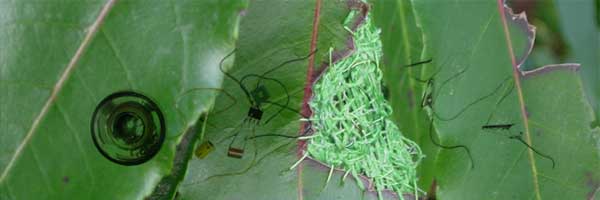
Preying Insect Robots by Peter Courtemanche, © 2005
This piece consists of a set of clawed robots that move about and communicate using a wireless Internet connection. The robots can follow pathways and climb over small obstacles. By talking to each other through "the ether", the robots engage in choreographed group activities. Each insect is approximately the size of a human hand. As they move about, the sound of their motors, motion, and engagement create an eerie soundtrack. These robots are modeled after an imaginary jade-green preying mantis - a mechanical creature that is described in the "Martian Chronicles" (by Ray Bradbury). One of the central ideas of Bradbury's Martian society is a seamless integration between technology and nature; intelligence and animal instinct; dream and reality (the Martians are telepathic). Preying insect robots looks at the way electro-mechanical processes can both mimic and integrate into life processes. The insect-robot's usefulness or position in the "web of life" is suspect. It raises questions about industrial and technological philosophies and ethics.
Photographs of the insects can be found here.
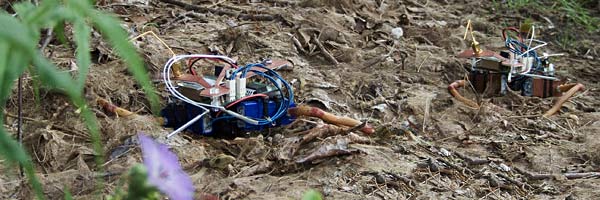
Resin Cloud by David Floren, © 2007
Resin Cloud consists of four pollen collectors and a steel upright "pine tree branch". The pollen collectors are yellow, weather-vane-like sculptures that point into the wind and count the number of particles flowing into their pollen detectors. The number of pollen particles is then transmitted by radio to the functional equivalent of a robotic pine tree bough. This is a tall rectangular base with a post protruding out the top of it. At the top of the post is a "seeder" or robotic "pine-cone". When a certain amount of pollen has been collected, the "seeder" bursts into action and emits a huge yellow cloud of tumeric. This happens every hour on a windy day, and less often when the air is calm. Placed among a grove of tall conifers, the piece catches the invisible particles from the trees and surrounding undergrowth, and mimics the natural seed dispersion process known as dehiscence.
Photographs of the work can be found here.
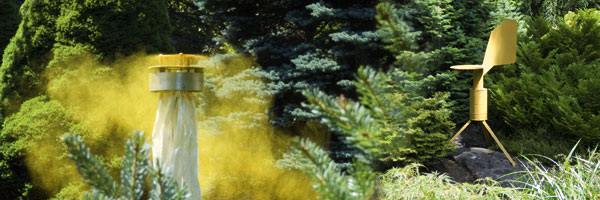
Gregory's Sun Suckers by Ken Gregory, © 2004
Sun Suckers is a sound installation consisting of multiple electronic insect-like audio micro-organisms which work together as a group. The organisms live outside and are powered by solar energy. They behave in a similar fashion to a cricket. If you pay attention to a cricket you can figure out what the temperature is going to be by the way it sings its song. Each member of the group is able to communicate, listen (receive) and talk (transmit) to all the others. The group works together creating a multi-layered soundscape of songs by passing information back and forth.
This experience to the listener is somewhat like standing in a rural area with grasshoppers, crickets, birds, or frogs sounding. Small sounds come from all directions but it is almost impossible to see the critters. The system consists of eight small identical microprocessor based electronic micro sound organism units mounted on poles that are planted in the ground. Each unit operates independently but will work with the others as a group transmitting, receiving and reacting to the environment and themselves. The installation questions and comments on issues of artificial life, sound pollution, and the impact of technology on the environment.
This installation is a continuation of research done on solar powered electronic sound 'micro-organisms' explored during a media arts wilderness retreat, February 2002 in Tasmania Australia.
Ken Gregory has posted images from the show on his BLOG.
Photographs of the Sun Suckers can be found here.
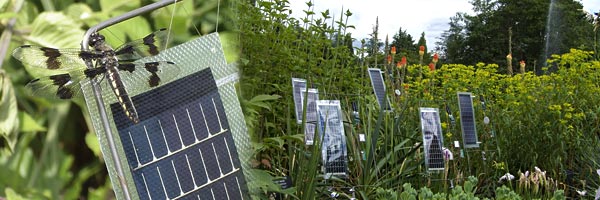
Ponderer by Matt Smith, © 2007
Ponderer is a solar powered paddle-wheeler - a boat that searches out the sun and attempts to navigate through a pond and track ducks and fish through changes in light and shadow. It moves slowly through the weed filled ponds of the gardens, never really certain if it is following a fish or a movement in the reeds and water lilies. On bright sunny days, the boat moces quickly, often misdirected by the dappling of light off of the waves. On cloudy days, it moves more slowly and predictably. This photo-vore (a robot that is dependent on the sun for its energy), also has a instinct to hide by moving through the shadows. This places it in a constant state of indecision - needing sun light to power itself, but needing shade to feel safe from passersby.
Photographs of the Ponderer can be found here.
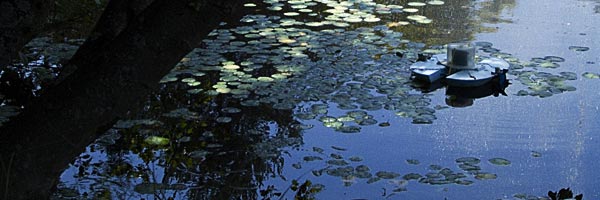
Madame Doolittle's Auditory Hive by Lori Weidenhammer, © 2006
Yolanda Doolittle is a fictional Edwardian entomologist and Theosphist that has been "re-incarnated" by Lori Weidenhammer. Madame Doolittle developed a unique body of research into an area of science that continues to be a hotly researched topic: honeybee communication. As well as creating a system of notation for a language that combined human phonetics and musical notes with the buzzing and humming sounds of bees, Doolitle developed a number of inventions for communicating with honeybees, including the Auditory Hive and the Beespeaker Milinery. The Auditory Hive was a unique wooden hive shaped like a skep. It contained a listening tube and a built in mouth-piece that allowed the scientist to "listen" and "talk" to the bees. Lori has created a new version of the auditory hive - a canvas hood in the shape of a skep that is suffused with the scent of beeswax. Audience members can put their head inside this virtual hive and hear the sounds of the hive's interior. Performing the persona of Madame Doolittle, Lori Weidenhammer works with the public to discuss issues of bio-diversity, bees, agriculture, and gardens from both a contemporary and folk-historical perspective.
Lori Weidenhammer has posted writing and images from the show on her Beespeaking Site.
Photographs of the Auditory Hive can be found here.
